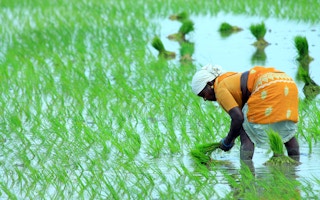Nothing in India is as terrifying as the thought that the monsoon might not come.
Around half of India’s population, some 600 million people, still depend on farming, and nearly two-thirds of fields have no irrigation. Without rain at the right time, hundreds of millions of people would see their incomes crash. Food costs would rise. And as India is an emerging global giant in food production, exporting more rice than anyone, droughts could push up global prices.
Waiting for the monsoon is an annual ritual. In the early summer, temperatures and frustration rise. For villagers there is irritable inactivity as farmers yearn to start planting. The rich can retreat under air-conditioners. It is those who labour in temperatures well above 40°C who most risk heart attacks and heat-stroke.
Newspapers produce maps tracking the fronts of black clouds as if they were an approaching, welcome, army. The moment of respite, usually late June for Delhi, is joyful. Cities erupt in delight as fat, dust-filled raindrops flop down. Novelists, poets and film-makers revel in the instant.
So imagine the anguish when relief does not arrive. A seriously late monsoon, or an unpredictable or scanty one, can be devastating. An uneven monsoon, which unloads its waters in a few, overwhelming torrents can destroy fortunes. Mumbai in 2005 was all but washed away by intense downpours far stronger than anyone could remember. Immense cloudbursts in Uttarakhand killed over 6,000 people in 2013.
In India the monsoon months of June to September provide three-quarters of total rainfall, an average of 89cm (35 inches). But in four out of ten years it proves erratic. Evidence from the past quarter-century suggests the Indian monsoon is growing less stable.
The Intergovernmental Panel on Climate Change (IPCC), in its latest report on the scientific consensus on the Indian monsoon, says “future increase in precipitation extremes related to the monsoon is very likely” and estimates, for South Asia, “normal monsoon years are likely to become less frequent in the future”. It recalls “abrupt shifts” in the Indian monsoon in the past 1,000 years that gave rise to “prolonged and intense droughts”.
Climate change should mean more rain for India. Over the past six decades its land mass has been warming. Orchards are being planted on higher slopes than before; Himalayan glaciers are retreating. In theory, more heat means more evaporated water in the air and thus wetter, longer monsoons, good for recharging reservoirs, rivers and groundwater.
Yet India’s air is also getting more polluted. More particles in the air probably explain why rainfall has in fact been declining slightly overall, says the IPCC. More particle-filled air could also mean monsoons dropping water in ever more intense, destructive bursts.
Other unknowns include doubts about the formation of deep depressions out at sea, and questions of how declining snow cover in the Himalayas might affect the northern reach of the summer rains. It is safe to predict more unpredictability.
Stealing India’s thunder
There are profound risks. Heidi Cullen of Climate Central, an American research group, says a failing monsoon would have “huge” consequences: “The country lacks large reservoirs that can moderate a drought’s impact on food supplies.”
History offers clues. The years 1876 and 1877 saw deadly hunger in southern India. In 1877 The Economist said the area become “fatally exposed” to famines, as “the soil is poorer, barren tracts are more frequent”. Later that year the monsoon in southern India in effect failed: nearly 30 per cent of areas suffered severe drought, and another 30 per cent moderate drought. Tens of millions went hungry, were impoverished as food prices soared, displaced to relief camps or forced off their land. Several million people died.
Political consequences followed. During famines colonial rulers continued to export grain. Anger about that became a spur to those who sought independence.
What if monsoons failed today? Indian farmers rarely have insurance and their savings are typically low. A single bad monsoon would be nasty, but two or three in a row could spur migration into cities. Upheaval would probably also affect Pakistan and Bangladesh that depend on the same monsoon. Potentially a fifth of the world’s population would be directly affected.
But unlike the India of 1877, the country has structures to mitigate the effects. State-run granaries exist to release rations when supplies grow tight. Democratic rulers are quick to stop exporting crops in times of hunger.
Better technology and more capacity for assessing climate data mean warnings of bad weather are improving. India could invest more in reservoirs, small-scale water harvesting, drip irrigation and crops better able to withstand droughts or grow in brackish water. And India must one day get to grips with terrible air pollution. Reducing that could yet mean more rain in the monsoon.
Adam Roberts is The Economist’s South Asia bureau chief, in Delhi. He tweets as @ARobertsjourno. This article was written for Eco-Business. A version of this article originally ran in The Economist’s Special Report – The World If, a compilation of scenarios of what might happen across politics, business and technology.











